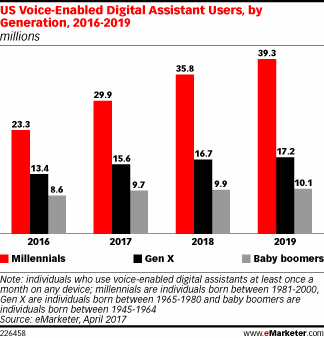The world has seen some massive shifts in 2020, but when it comes to the world of search this year, no other segment has grown larger than voice search. So, it is official: we talk to computers and computers talk to us back. We tell them to order us food when we’re hungry and play our favourite playlists. When we head to bed, we ask them to turn off the lights and lock the doors.
But how does this shift affect the business world and marketing? Are consumer behaviours shifting as well? At Wingman, every marketing campaign we build is driven by data. In fact, it’s one of Wingman’s 4 main pillars of marketing. That’s why Wingman reads countless research articles to stay up to date with the latest marketing trends.
Let’s look at 10 interesting voice search statistics of 2020 you may not have known about:
1. Users are 3x more likely to use mobile devices for voice search.
A study done by Adobe Analytics surveyed over 1,000 US consumers to study voice search behaviour and activities. They found the most common voice search activities included music (70%), weather forecasts (64%) and asking questions (53%). However, the most interesting statistic is how common smartphones are as the go-to device for voice search. Smartphones are 3 times more likely to be used daily for voice search than other types of devices.
2. 31% of smartphone users worldwide use voice search at least once a week.
The number of voice searches across the globe are quickly increasing. Statista found that nearly a third of the world’s smartphone users use voice search at least once a week. Furthermore, the market for additional smart speakers has not yet ceased. 45% of smart speaker owners plan to buy another one in the future. In one of our previous blogs, we talked about the average number of connected devices in a common household. We wholly suspect this number to continue to grow.
3. 72% of users that own a voice-activated speaker say the device is part of their daily routine.
Deciding on a birthday gift for a friend? Voice-activated speakers aren’t just a gift for tech-savvy enthusiasts anymore. Voice search is becoming the norm. It allows users to multitask, perform tasks faster, and instantly find answers to their questions. In fact, Google’s marketing research and insights website Think with Google found that 72% of voice-activated speaker owners use voice search often as part of their daily routine. It’s no wonder why voice search adoption has grown so quickly.
4. Mobile voice searches are 3x more likely to be local based than text.
Now that voice search has become more convenient and accurate than ever, users are using it to find information on stores like directions, hours of operations, or product selection. It was found that mobile voice searches 3x times more likely to ask local-based questions than text.
5. 60.5 million Americans use voice-enabled digital assistants at least once a month.
In a research survey conducted by eMarketer, 60.5 million Americans (or one-fifth of the population) use some type of voice-enabled assistant; the largest segment was Millennials at 39.3%, followed by 17.2% of Gen X users, and 10.1% of Baby Boomers. eMarketer has also found that the largest share of the market is owned by Amazon’s Echo at 70.6% and Google’s Home products follow at a meager 23.8%.

Source: eMarketer
6. Up to 43% of voice-enabled device owners use it to shop.
In a study done by Narvar, it was observed that consumers of all age groups have used their voice-enabled device to shop, but the age group with the highest adoption were those aged 45-60.

Source: Narvar
Narvar continues the study with other findings. Several behaviours were surveyed, from researching products to reordering items. Perhaps the most intriguing statistic is 22% of users make purchases using their voice. With the proliferation of voice-activated speakers including screens, we suspect the process of ordering by voice will be further simplified.

Source: Narvar
7. 20% of mobile queries are voice-activated search.
Google presented this statistic back in 2016. With support for 119 languages and its prevalence in almost all modern smartphones, this number is higher now than it was 4 years ago.
8. 52% of speakers are found in common rooms.
Google has statistics on where voice-activated speakers are in the home. It was found that 52% of speakers are set up within common rooms (family rooms, living rooms, etc.) followed by bedrooms at 25% and kitchen at 22%.
9. 8 billion people will be using digital assistants by 2023.
According to Statista, 3.25 billion people currently use voice-activated search and digital assistants worldwide. That’s nearly half of the world’s total population. This number is expected to reach 5 billion by 2021, 6.4 billion by 2022, and 8 billion people by 2023.
10. 17% of users use voice to reorder items online.
The coronavirus has permanently shifted the way companies do business and how workers do their daily tasks. What we at Wingman find most eye-catching is how consumer behaviour has shifted as well. 17% of users use voice to reorder items online and is expected to continue to rise. The longer COVID-19 remains a pandemic, the more ingrained digital purchasing behaviours become.
Whether you use it daily, occasionally, or not at all, voice search is here to stay. While it may never fully replace text-based searches, it has become an integral part to the search engine marketing mix.
What do you think? If you are not already a user of digital voice assistants, are you more interested in using it now? Are you a business looking to stay ahead of your customers shifting shopping behaviours? We got your back!
For a donation of $25 to our local Make-a-Wish Foundation, you can book a Wingman today for a 30-minute consultation. We’ll give you an in-depth analysis on how you can take advantage of emerging trends and stay on top of it. We’ll also match your donation, totalling $50 to Make-A-Wish. You gain insight into building your business and our charity of choice receives a donation. It’s a win-win situation! To learn more, please head to our Wingman Wishes page.

